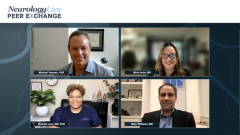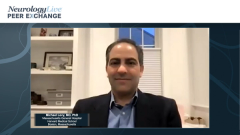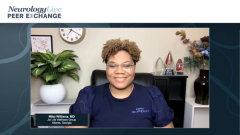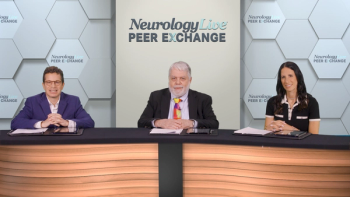
Overview of Neuromyelitis Optica Spectrum Disorder
Expert neurologists identify key differences between neuromyelitis optica spectrum disorder (NMOSD) and multiple sclerosis, and discuss the importance of accurate disease diagnosis.
Episodes in this series

Michael Yeaman, PhD: Hello, and thank you for joining the NeurologyLive® program titled, “Neuromyelitis Optica Spectrum Disorder Care in Diverse Patient Populations.” I’m Dr Michael Yeaman, a professor of medicine at the David Geffen School of Medicine, and chief of molecular medicine and vice chair of the department of medicine at Harbor-UCLA [University of California, Los Angeles] Medical Center. We’re very fortunate to be joined by 3 experts. First, Dr Mirla Avila is an associate professor of neurology and a neurology specialist in NMOSD [neuromyelitis optica spectrum disorder] from the Texas Tech University in Lubbock. Mirla, thank you for joining.
Mirla Avila, MD: Thank you so much.
Michael Yeaman, PhD: We have Dr Mitzi Williams, a neurologist and the founder and medical director of Joi Life Wellness Group in Atlanta, Georgia. Mitzi, thanks for being here.
Mitzi Williams, MD: Excited to be here.
Michael Yeaman, PhD: And we have Dr Michael Levy, an NMOSD and MOGAD [myelin oligodendrocyte glycoprotein antibody-associated disease] specialist, neurologist, and the research director of the division of neuroimmunology and neuroinfectious disease at Massachusetts General Hospital and Harvard Medical School in Boston. Michael, thanks so much for being here.
Michael Levy, MD, PhD: Thank you for inviting me.
Michael Yeaman, PhD: We’ll be discussing neuromyelitis optica spectrum disorder in racially and ethnically diverse patient populations. We’ll try to highlight diagnosis, treatment, and management considerations as well as how to better treat and engage these patient populations in clinical trial and therapeutic development efforts. Thanks so much for joining us. Let’s begin.
Let’s start with an overview of NMOSD so that we can bring everybody together on the same page. One of the key questions is, what is NMOSD, neuromyelitis optica spectrum disorder, and how is it different from multiple sclerosis [MS]? Maybe I could ask each of you how would you summarize the difference between NMOSD and MS in 1 or 2 sentences. Mirla, we could start with you.
Mirla Avila, MD: Sure. NMOSD is an immune-driven condition that basically targets the astrocytes, aquaporin-4 channels, which is different from MS. The target is different. The extent of the lesion that we see with NMO [neuromyelitis optica] is also longer. For example, the…segments will be more than 3 segments. There’s more predominant involvement of the optic nerve and spinal cord. One of the main differences is that when there’s a relapse, it’s usually much more aggressive than what we see with MS, with sometimes only partial improvement.
Michael Yeaman, PhD: Thanks so much. Mitzi, what would you add to that?
Mitzi Williams, MD: I absolutely agree with everything Mirla stated. In addition, from a clinical standpoint, it’s very different from MS in that each individual relapse can be devastating, so it’s extremely important for people to come to care and be diagnosed as early as possible so that we can try to prevent disability in the long term. Another thing that distinguishes it from multiple sclerosis is that people often have bilateral optic neuritis. It may not be simultaneous, but there’s a potential that people could have devastating loss of their vision, so it’s extremely important that people aren’t misdiagnosed and that they come to care as soon as possible.
Michael Yeaman, PhD: Thanks, Mitzi. All great points. We’ll get to some of those other points in a moment. Michael, how would you characterize the differences and similarities here?
Michael Levy, MD, PhD: I’d add that from an immunological perspective, these 2 diseases are really different. Multiple sclerosis seems to live in the central nervous system and it’s primarily demyelinating disease, whereas neuromyelitis optica doesn’t live in the nervous system. It probably lives in the bloodstream or in lymph nodes and then periodically attacks astrocytes, the aquaporin-4 water channel. It involves different parts of the immune system, including the complement system. There’s some overlap in treatments, especially with B-cell depletion, but there are a lot of MS therapies that are very harmful in NMO, so we know that immunopathologically, these are very different diseases.
Michael Yeaman, PhD: Great points. That brings us to the next logical idea. Why is it so important to accurately diagnose MS vs NMOSD and be very rapid about that? Mitzi, maybe I could turn to you to get us started on that point please.
Mitzi Williams, MD: Absolutely. A large percentage of people with NMOSD have traditionally been misdiagnosed with multiple sclerosis, as NMOSD used to be considered a part of or a subset of MS. Now that we have testing available, aquaporin-4 antibody testing, which is a serum test that people can receive, it’s very important that people are not only tested but that they have the appropriate test. There are cell-based assays that they can have as well as a different test, the ELISA [enzyme-linked immunoassay] test, and it’s important that people have the correct test to make sure that we’re accurately diagnosing it.
More importantly, because of the potential devastation of disease, I recently had a patient who was diagnosed with NMOSD, and unfortunately by the time she was diagnosed at the age of 25, she was blind. If we don’t catch these people early, diagnose them appropriately, and get them on the appropriate treatment, it could have potentially devastating consequences for the majority of their lives.
Michael Yeaman, PhD: Thanks a lot, Mitzi. Mirla, how would you expand on that in terms of comparisons among different populations you might see?
Mirla Avila, MD: One of the differences would be that patients with NMOSD can be diagnosed a little later in their life, in their 40s or even 50s. I had a 50-year-old woman who came in with optic pain, and she was initially treated thinking that it was a giant cell arteritis. I have seen others who are treated initially with the thinking that these are embolic strokes and not NMO. Because it’s later in life, sometimes it can take longer for the diagnosis. As Mitzi was saying, the problem is that this delay can lead to consequences. The other important thing that was mentioned is that many of the MS therapies could actually worsen NMOSD. If they’re misdiagnosed with MS and you treat them with something different than B-cell therapy, that could also worsen the condition.
Michael Yeaman, PhD: Thanks, Mirla. Michael, you’ve done some work with respect to the speed and accuracy with which diagnosis is performed. Do you want to say something about the pace of diagnosis and how important it is to catch this early?
Michael Levy, MD, PhD: We have made a lot of progress. In 1999, the misdiagnosis rate was 95%. In 2012, it was down to 30%. Clearly, we can do better, but one of the incentives for doing better isn’t just the fear that patients can do poorly if misdiagnosed, but that patients can do really well if diagnosed well. We know that patients who are treated where we can prevent attacks shouldn’t accrue disability outside of relapses in NMOSD. It’s one of the silver linings of having this disorder, that if you can prevent all future attacks, patients should never get worse than they are at the time.
Michael Yeaman, PhD: Well said.
Transcript Edited for Clarity
Newsletter
Keep your finger on the pulse of neurology—subscribe to NeurologyLive for expert interviews, new data, and breakthrough treatment updates.



























